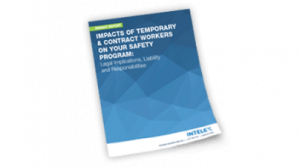INSIGHT REPORT
Impacts of Temporary & Contract Workers on Your Safety Program
Legal Implications, Liability and Responsibilities

The arrangement offers benefits for workers, too; many who work on a contract or contingent basis have chosen to do so and prefer to work this way.
Hiring non-permanent workers, however, creates unique challenges for health and safety departments and the programs they oversee. A new Insight Report from Intelex and BLR takes an in-depth look at this form of labor and its effects on employers’ H&S programs. It looks at such aspects as:
- Who’s Doing What – A look at what constitutes non-permanent work and the differences between its various forms.
- Temporary Workers, Responsibility, and Liability — examining the legal obligations of employers who bring in temporary and contract labor and the key expectations of regulatory bodies like OSHA.
- The impact of temporary and contract workers on safety programs.
 1 877 932 3747
1 877 932 3747




